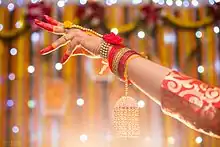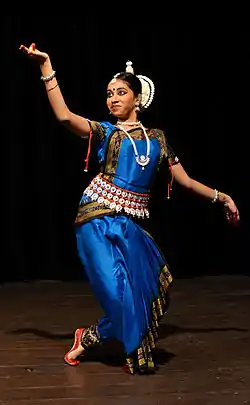Alta (dye)
Alta (Bengali: আলতা) (Odia: ଅଳତା), alah or mahavar is a red dye that is applied to the hands and feet of women, mainly in the Indian subcontinent.[1][2][3][4][5][6][7][8] It is applied with a cotton swab or brush to the hands and feet during marriage ceremonies and festivals.

Alta was originally produced from lac, although today it is mainly replaced with synthetic dyes.[9]

Bengali cultural significance
Alta has great cultural significance in Bengali culture.[10][11][12][13] Regardless of religious beliefs, Bengali women in Bangladesh and Indian States of West Bengal traditionally adorn their hands and feet with alta for marriage[14][15] and cultural festivals like Pahela Baishakh, Pahela Falgun and others.[16][17][18]
Odissi cultural significance
Alta is also significant in Odisha. It can be commonly seen worn by Odissi classical dancers on hands and feet while performing. It is especially prevalent during Raja, which is a three-day festival celebrating womanhood (menstruation). During this festival, as a part of the ritual, women apply alta on their feet symbolising fertility and auspiciousness. Alta and turmeric is also applied during marriages in Odia culture.
References
- "আলতা | কালের কণ্ঠ". Kalerkantho (in Bengali). Retrieved 17 October 2020.
- বাংলাদেশ, Daily Bangladesh :: ডেইলি. "আলতা রাঙা পা". Daily Bangladesh. Retrieved 17 October 2020.
- "আলতা রাঙা পদ যুগল!". Shajgoj. 3 December 2017. Retrieved 17 October 2020.
- প্রামাণিক, কল্লোল. "পায়ে আলতা পরিয়ে শুভলগ্ন রাঙিয়ে তোলেন তিনি". anandabazar.com (in Bengali). Retrieved 17 October 2020.
- "Bengali Hindu Wedding - Rituals, Customs, Dress, Food". www.culturalindia.net. Retrieved 17 October 2020.
- "Newari girls participate in mass Bel Bibaha [with photos]". kathmandupost.com. Retrieved 17 October 2020.
- Shrestha, Shreeya (November 2017). "An Elaborate Ritual called Marriage". ECS NEPAL. Retrieved 17 October 2020.
- Guha, Sanjana (1 April 2019). "Learn How Bengali Mehndi Blends Simplicity, Authenticity and Ethnicity on the Wedding Day". WeddingWire.in. Retrieved 17 October 2020.
- "আলতা | কালের কণ্ঠ". Kalerkantho (in Bengali). Retrieved 17 October 2020.
- "আলতা | কালের কণ্ঠ". Kalerkantho (in Bengali). Retrieved 29 September 2020.
- https://www.shajgoj.com/7-steps-to-apply-alta/
- বাংলাদেশ, Daily Bangladesh :: ডেইলি. "আলতা রাঙা পা". Daily Bangladesh. Retrieved 15 October 2020.
- প্রামাণিক, কল্লোল. "পায়ে আলতা পরিয়ে শুভলগ্ন রাঙিয়ে তোলেন তিনি". anandabazar.com (in Bengali). Retrieved 16 October 2020.
- https://www.e-barta247.com/archive/details?n=5507
- "Learn How Bengali Mehndi Blends Simplicity, Authenticity and Ethnicity on the Wedding Day". www.weddingwire.in. Retrieved 16 October 2020.
- "আলতা রাঙা বৈশাখ :: দৈনিক ইত্তেফাক". archive.ittefaq.com.bd (in Bengali). Retrieved 30 December 2020.
- "আলতা পরা পায়ে". m.newsg24.com. Retrieved 30 December 2020.
- "বৈশাখী উন্মাদনার ঢেউ শাবিতে". banglanews24.com (in Bengali). Retrieved 30 December 2020.